Table of Contents
hide
AWS Network Connectivity Options
Internet Gateway
- provides Internet connectivity to VPC
- is a horizontally scaled, redundant, and highly available component that allows communication between instances in your VPC and the internet.
- imposes no availability risks or bandwidth constraints on your network traffic.
- serves two purposes: to provide a target in the VPC route tables for internet-routable traffic and to perform NAT for instances that have not been assigned public IPv4 addresses.
- supports IPv4 and IPv6 traffic.
NAT Gateway
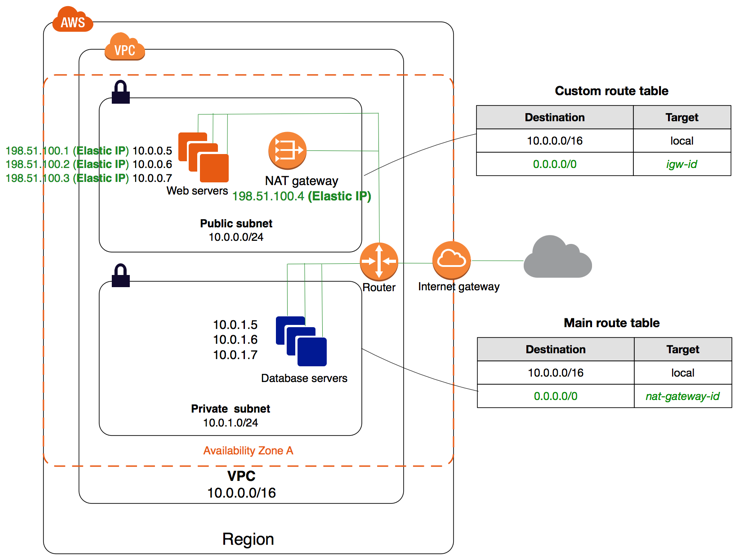
- enables instances in a private subnet to connect to the internet or other AWS services, but prevents the Internet from initiating connections with the instances.
- Private NAT gateway allows instances in private subnets to connect to other VPCs or the on-premises network.
Egress Only Internet Gateway
- NAT devices are not supported for IPv6 traffic, use an Egress-only Internet gateway instead
- Egress-only Internet gateway is a horizontally scaled, redundant, and highly available VPC component that
- Egress-only Internet gateway allows outbound communication over IPv6 from instances in the VPC to the Internet and prevents the Internet from initiating an IPv6 connection with your instances.
VPC Endpoints
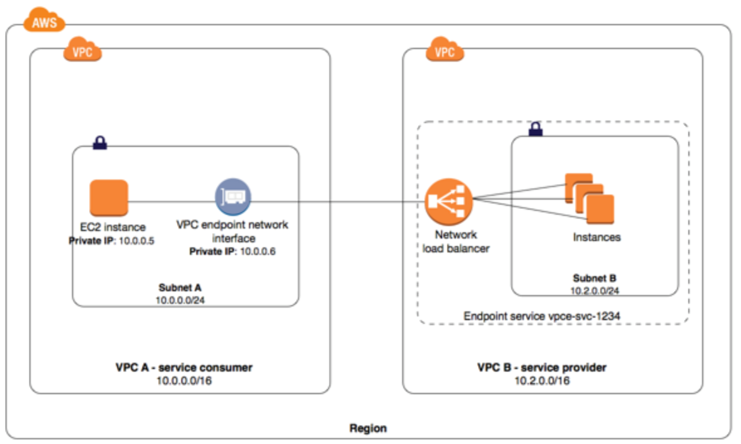
- VPC endpoint provides a private connection from VPC to supported AWS services and VPC endpoint services powered by PrivateLink without requiring an internet gateway, NAT device, VPN connection, or AWS Direct Connect connection.
- Instances in the VPC do not require public IP addresses to communicate with resources in the service. Traffic between the VPC and the other service does not leave the Amazon network.
- VPC Endpoints are virtual devices and are horizontally scaled, redundant, and highly available VPC components that allow communication between instances in the VPC and services without imposing availability risks or bandwidth constraints on the network traffic.
- VPC Endpoints are of two types
- Interface Endpoints – is an elastic network interface with a private IP address that serves as an entry point for traffic destined to supported services.
- Gateway Endpoints – is a gateway that is a target for a specified route in your route table, used for traffic destined to a supported AWS service. Currently only Amazon S3 and DynamoDB.
VPC Private Links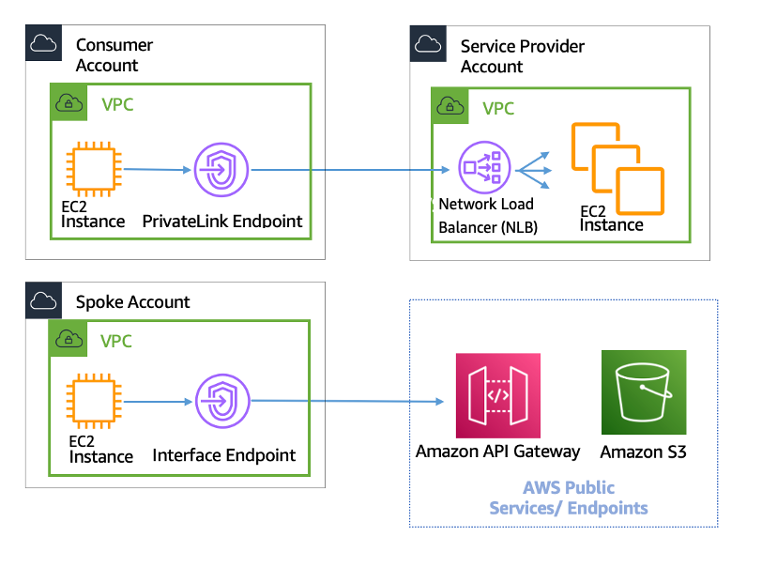
- provides private connectivity between VPCs, AWS services, and your on-premises networks without exposing your traffic to the public internet.
- helps privately expose a service/application residing in one VPC (service provider) to other VPCs (consumer) within an AWS Region in a way that only consumer VPCs initiate connections to the service provider VPC.
- With ALB as a target of NLB, ALB’s advanced routing capabilities can be combined with AWS PrivateLink.
VPC Peering

- enables networking connection between two VPCs to route traffic between them using private IPv4 addresses or IPv6 addresses
- connections can be created between your own VPCs, or with a VPC in another AWS account.
- enables full bidirectional connectivity between the VPCs
- supports inter-region VPC peering connection
- uses existing underlying AWS infrastructure
- does not have a single point of failure for communication or a bandwidth bottleneck.
- VPC Peering connections have limitations
- cannot be used with Overlapping CIDR blocks
- does not provide Transitive peering
- does not support Edge to Edge routing through Gateway or private connection
- is best used when resources in one VPC must communicate with resources in another VPC, the environment of both VPCs is controlled and secured, and the number of VPCs to be connected is less than 10
VPN CloudHub
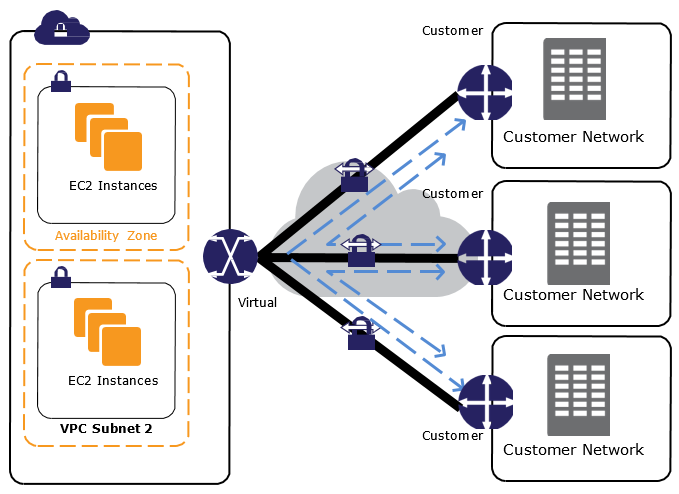
- AWS VPN CloudHub allows you to securely communicate from one site to another using AWS Managed VPN or Direct Connect
- AWS VPN CloudHub operates on a simple hub-and-spoke model that can be used with or without a VPC
- AWS VPN CloudHub can be used if you have multiple branch offices and existing internet connections and would like to implement a convenient, potentially low cost hub-and-spoke model for primary or backup connectivity between these remote offices.
- AWS VPN CloudHub leverages VPC virtual private gateway with multiple gateways, each using unique BGP autonomous system numbers (ASNs).
Transit VPC
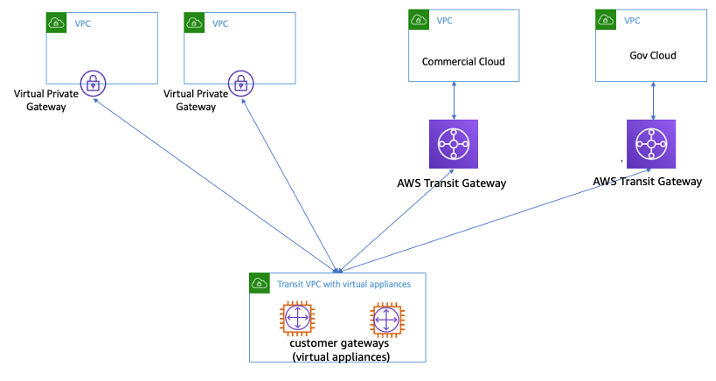
- A transit VPC is a common strategy for connecting multiple, geographically disperse VPCs and remote networks in order to create a global network transit center.
- A transit VPC simplifies network management and minimizes the number of connections required to connect multiple VPCs and remote networks
- Transit VPC can be used to support important use cases
- Private Networking – You can build a private network that spans two or more AWS Regions.
- Shared Connectivity – Multiple VPCs can share connections to data centers, partner networks, and other clouds.
- Cross-Account AWS Usage – The VPCs and the AWS resources within them can reside in multiple AWS accounts.
- Transit VPC design helps implement more complex routing rules, such as network address translation between overlapping network ranges, or to add additional network-level packet filtering or inspection.
- Transit VPC
- supports Transitive routing using the overlay VPN network — allowing for a simpler hub and spoke design. Can be used to provide shared services for VPC Endpoints, Direct Connect connection, etc.
- supports network address translation between overlapping network ranges.
- supports vendor functionality around advanced security (layer 7 firewall/Intrusion Prevention System (IPS)/Intrusion Detection System (IDS) ) using third-party software on EC2
- leverages instance-based routing that increases costs while lowering availability and limiting the bandwidth.
- Customers are responsible for managing the HA and redundancy of EC2 instances running the third-party vendor virtual appliance
Transit Gateway

- is a highly available and scalable service to consolidate the AWS VPC routing configuration for a region with a hub-and-spoke architecture.
- is a Regional resource and can connect VPCs within the same AWS Region.
- TGWs across different regions can peer with each other to enable VPC communications within the same or different regions.
- provides simpler VPC-to-VPC communication management over VPC Peering with a large number of VPCs.
- enables you to attach VPCs (across accounts) and VPN connections in the same Region and route traffic between them.
- support dynamic and static routing between attached VPCs and VPN connections
- removes the need for using full mesh VPC Peering and Transit VPC
Hybrid Connectivity
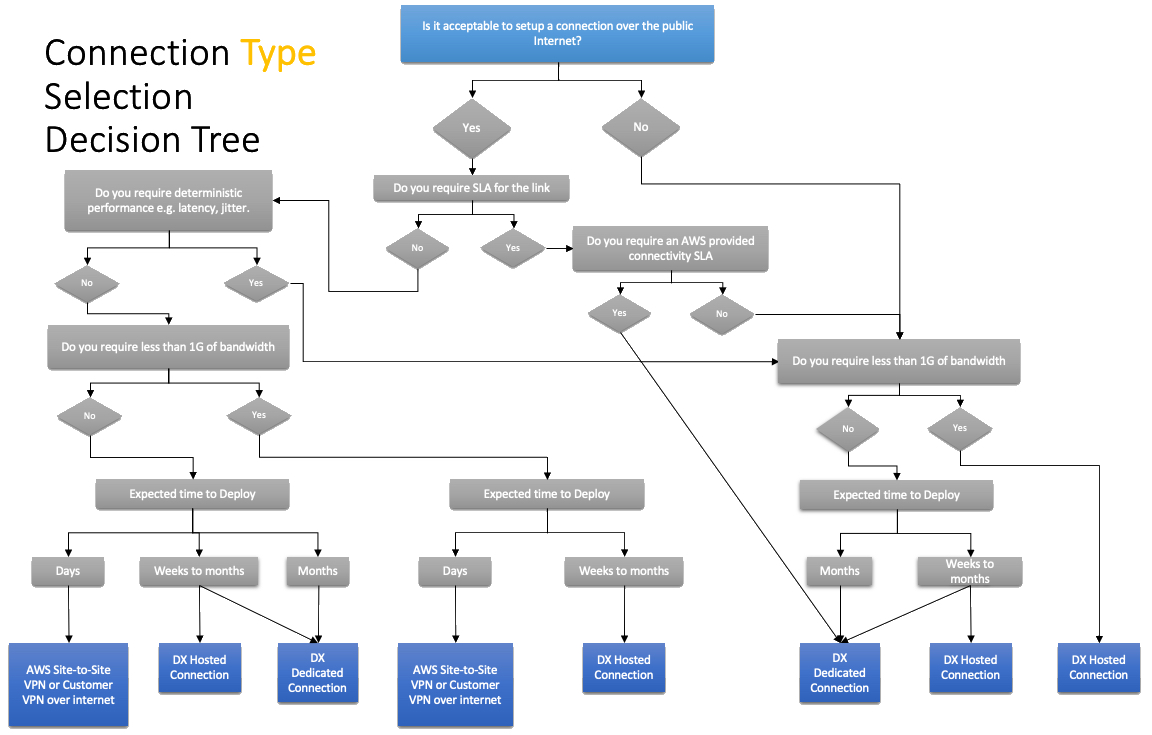
Virtual Private Network (VPN)
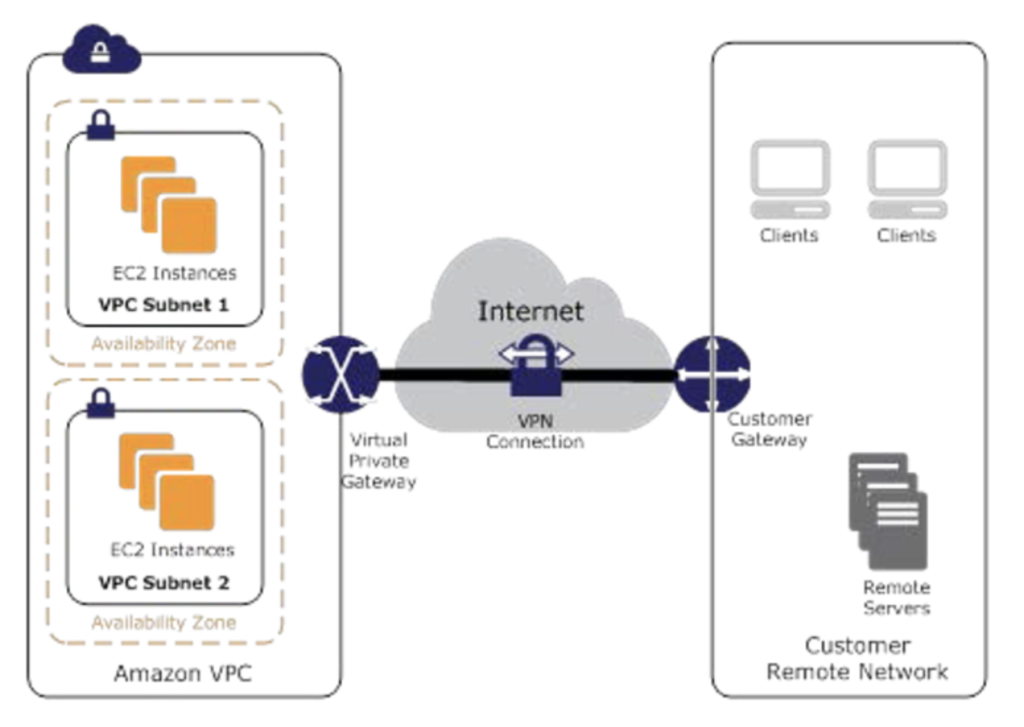
- VPC provides the option of creating an IPsec VPN connection between remote customer networks and their VPC over the internet
- AWS managed VPN endpoint includes automated multi–data center redundancy & failover built into the AWS side of the VPN connection
- AWS managed VPN consists of two parts
- Virtual Private Gateway (VPG) on AWS side
- Customer Gateway (CGW) on the on-premises data center
- AWS Managed VPN only provides Site-to-Site VPN connectivity. It does not provide Point-to-Site VPC connectivity for e.g. from Mobile
- Virtual Private Gateway are Highly Available as it represents two distinct VPN endpoints, physically located in separate data centers to increase the availability of the VPN connection.
- High Availability on the on-premises data center must be handled by creating additional Customer Gateway.
- AWS Managed VPN connections are low cost, quick to setup and start with compared to Direct Connect. However, they are not reliable as they traverse through Internet.
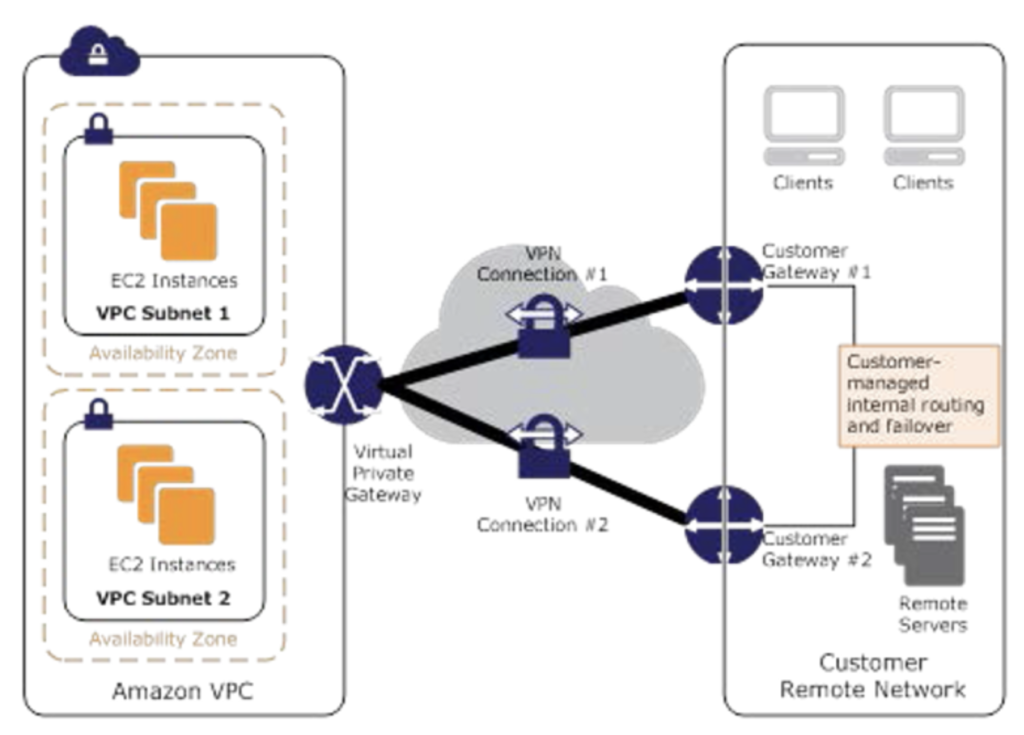
Software VPN
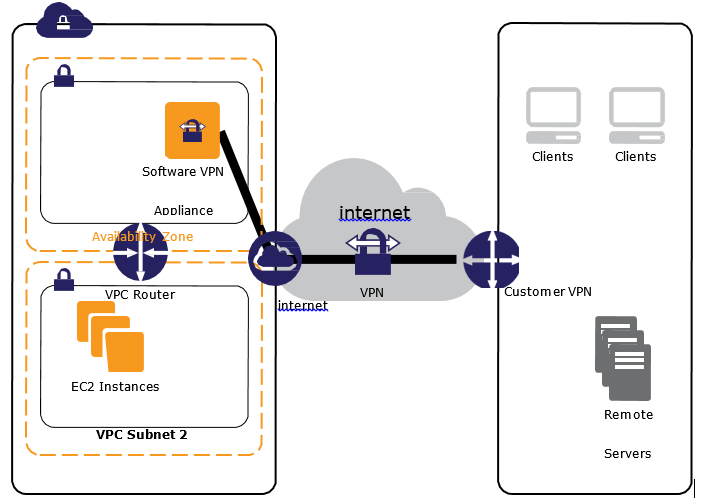
- VPC offers the flexibility to fully manage both sides of the VPC connectivity by creating a VPN connection between your remote network and a software VPN appliance running in your VPC network.
- Software VPNs help manage both ends of the VPN connection either for compliance purposes or for leveraging gateway devices that are not currently supported by Amazon VPC’s VPN solution.
- Software VPNs allows you to handle Point-to-Site connectivity
- Software VPNs, with the above design, introduces a single point of failure and needs to be handled.
Direct Connect – DX

- AWS Direct Connect helps establish a dedicated private connection between an on-premises network and AWS.
- Direct Connect can reduce network costs, increase bandwidth throughput, and provide a more consistent network experience than internet-based or VPN connections
- Direct Connect uses industry-standard VLANs to access EC2 instances running within a VPC using private IP addresses
- Direct Connect lets you establish
- Dedicated Connection: A 1G, 10G, or 100G physical Ethernet connection associated with a single customer through AWS.
- Hosted Connection: A 1G or 10G physical Ethernet connection that an AWS Direct Connect Partner provisions on behalf of a customer.
- Direct Connect provides the following Virtual Interfaces
- Private virtual interface – to access a VPC using private IP addresses.
- Public virtual interface – to access all AWS public services using public IP addresses.
- Transit virtual interface – to access one or more transit gateways associated with Direct Connect gateways.
- Direct Connect connections are not redundant as each connection consists of a single dedicated connection between ports on your router and an Amazon router
- Direct Connect High Availability can be configured using
- Multiple Direct Connect connections
- Back-up IPSec VPN connection
LAGs
- Direct Connect link aggregation group (LAG) is a logical interface that uses the Link Aggregation Control Protocol (LACP) to aggregate multiple connections at a single AWS Direct Connect endpoint, allowing you to treat them as a single, managed connection.
- LAGs need the following
- All connections in the LAG must use the same bandwidth.
- A maximum of four connections in a LAG. Each connection in the LAG counts toward the overall connection limit for the Region.
- All connections in the LAG must terminate at the same AWS Direct Connect endpoint.
Direct Connect Gateway

- is a globally available resource to enable connections to multiple VPCs across different regions or AWS accounts.
- allows you to connect an AWS Direct Connect connection to one or more VPCs in the account that are located in the same or different regions
- allows connecting any participating VPCs from one private VIF, reducing Direct Connect management.
- can be created in any public region and accessed from all other public regions
- can also access the public resources in any AWS Region using a public virtual interface.
I think the below statement is wrong.
VPC Peering connections have limitations
– Can be used with Overlapping CIDR blocks
Thanks Deepak, corrected the same.
good summary